USA, INDIANA, ANDERSON, JANUARY 15 2005. PLANT FIRE BRINGS
CALL TO EVACUATE - WATER CAN'T BE USED TO DOUSE BLAZE AT MAGNESIUM FACTORY.
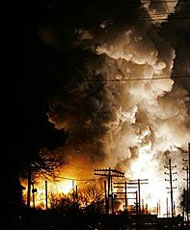
A fire at Advanced Magnesium Alloys Corp. in Anderson was first reported
about 4:30 p.m. Friday. About 8:30 p.m., the fire appeared to explode;
flames burst into the air, and heavy smoke spewed over the area.
Thousands of Anderson residents were urged to leave their homes in bitter
cold Friday when a fire at a magnesium recycling plant sent brilliant
flames and huge clouds of smoke towering into the sky. Despite intense
heat and potentially toxic fumes, no serious injuries were reported. Three
plant employees were treated for breathing problems, Anderson fire officials
said.
The local Mayor declared an emergency and ordered evacuations in a one-square-mile
area around the Advanced Magnesium Alloys Corp. plant at 1820 E. 32nd
St. State environmental officials were monitoring air around the plant
to assess the hazard to nearby residents. Officials said the cold, breezy
conditions Friday helped to reduce the potential danger.
Firefighters could do little but watch the blaze - visible from 10 to
15 miles away - as it burned out of control. Firefighters could not use
water, which can cause magnesium to explode, to put out the fire. Anderson
Fire Chief estimated the blaze could continue burning for three days.
By 12:30a.m. today, the flames had died down considerably.
A spokesman for the Madison County Emergency Management Agency, said
the fire was first reported at 4:30 p.m. Officials said 12 to 24 workers
were in the plant at the time; all got out. Officials initially evacuated
a six-block area surrounding the plant as a precaution. About 8:30 p.m.,
the fire appeared to explode; flames burst 300 feet into the air, and
heavy smoke descended over the entire area. The spoksman for the County
Emergency Management Agency said firefighters believe snow on the roof
collapsed onto the fire, causing a huge flare-up. "I thought D-Day
was here," said an Anderson resident, who saw the fire as he was
driving toward Muncie.
City officials expanded the evacuation to take in an area bounded by
Columbus Avenue on the west, Scatterfield Road on the east, 23rd Street
on the north and 38th Street on the south. A police spokesman said 8,000
to 10,000 people may be affected. Officers went through Anderson neighborhoods
with loudspeakers, urging residents to leave. One local resident didn't
need to be told. "I knew it was time to leave when it started looking
like a mushroom cloud," said the resident, who lives three blocks
from the plant. Another local resident was working at a nearby supermarket
when he and other employees heard "a big boom." "It looked
like a big atomic blast," he said.
State Emergency Management Agency planner said Indiana Department of
Environmental Management officials went to the scene to begin monitoring
the air. "They want to make sure evacuations go far enough out,"
he said. The Agency Planner said the state fire marshal's office was measuring
toxicity levels at several points around the plant. Magnesium is a silvery-white,
highly flammable metal that, when ignited, releases irritating or toxic
fumes. Magnesium fires are typically extinguished using dry sand.
The police spokesperson said the fire began with an estimated 4,000 to
6,000 pounds of magnesium in one section of the plant. "We're not
sure yet on what the start of it was," he said. The factory, which
Advanced Magnesium Alloys, or AMACOR, purchased in 2003, is in the sprawling
former Delco Remy plant site north of I-69. The police spokesperson said
that around 11 p.m., police arrested an apparently intoxicated man who
attempted to enter the plant and put out the fire with a fire extinguisher.
The man's identity was not released.
A Salvation Army shelter was opened about 11/2miles from the plant. Residents
also were being sent to Anderson High School. About 40 people had gathered
at the Salvation Army shelter by midnight. A Major of the Salvation Army
said evacuees may have to stay two to three days. A local couple who live
about eight blocks from the plant, were among those at the Salvation Army
shelter. They were worried about their two dogs and two cats but were
willing to stay as long as authorities felt it necessary. "I don't
know," The husband of the couple said. "We'll take what the
Lord gives us.
About the Anderson Magnesium Plant
Advanced Magnesium Alloys Corp. (AMACOR) supplies magnesium alloys to
the die-casting and the aluminum industries. It bills itself as the largest
magnesium recycling facility in the world. The annual production capacity
of the plant is approximately 30,000 metric tons.
Magnesium is a silver-white metal. Because of its light weight, it often
is used in alloys for aircraft and automobile parts. Recycled magnesium
represents a substantial source of the metal. Pure magnesium does not
occur in nature, and much of the magnesium used in the United States is
recovered from seawater. Because it burns with a brilliant white light,
magnesium is used in fireworks and incendiary bombs. Other uses include
tanning, dyeing and making cement, fertilizer and insulating materials.
Sources: AMACOR, World Book Encyclopedia, U.S. Geological Survey
USA, INDIANA, ANDERSON, JANUARY 15 2005. THOUSANDS EVACUATED
NEAR INDIANA PLANT FIRE
Magnesium fires, like the one in Anderson, Indiana,
are extremely difficult to extinguish
A magnesium fire at a recycling plant burned out of control Friday night,
forcing the evacuation of several thousand people from their homes. Hundreds
of firefighters rushed to the Advanced Magnesium Alloys Corp. plant after
the fire erupted. Explosions inside forced firefighters out less than
three hours later, although they continued working from outside the building,
said a police spokesman. "The whole building is engulfed now,"
the police spokesman said. "It's a bright glow, it's burning pretty
hard." There were no immediate reports of injuries.
Magnesium is a silvery-white, highly flammablemetal that, when ignited,
releases irritating or toxic fumes. Magnesium fires are typically extinguished
using dry sand since water can cause a flare-up or explosion.
Authorities evacuated about 5,000 people from an area about one mile
wide and two miles long that fell in the path of the smoke and fumes;
wind speeds were about 5 mph, the police spokesman said.
CNN, quoting an official with the Indiana State Emergency Management
Agency, reported that state officials initially planned to evacuate 30,000
residents -- about half the city's population. "[People are] afraid
the plant is gonna blow," said a local resident, who lives across
the street and upwind from the plant. "We heard a couple of explosions
that shook the house."
The police spokesman said the fire began with an estimated 4,000 to 6,000
pounds of magnesium in one section of the plant. "We're not sure
yet on what the start of it was," he said. Twelve to 18 of the plant's
approximately 70 workers were inside at the time, he said.
The factory is located in the sprawling former Delco Remy plant site.
Anderson is about 40 miles northeast of Indianapolis.
USA,ANDERSON INDIANA, WATER AIDED MAGNESIUM PLANT FIRE (SPRINKLERS SUSPECTED)
ANDERSON, Indiana (AP)
A magnesium recycling plant's sprinkler system helped turn a small fire
in a scrap bin into a toxic inferno that forced thousands of people from
their homes, fire investigators said.
Officials are trying to determine why the Advanced Magnesium Alloys Corp.
plant had a working sprinkler system in the same area where the metal
is stored. Water causes burning magnesium to flare up and explode. After
magnesium in a scrap bin caught fire Friday evening, plant workers immediately
tried to put it out with dry material, Anderson Deputy Fire Chief said.
"Before they could put it out, the sprinkler went off," he said
Saturday.
The water helped fuel the burning magnesium, which by Friday evening
forced the evacuation of about 5,000 nearby residents because of hazardous
fumes. Those residents were allowed to return home Saturday after the
fire subsided.
Officials said the plant's sprinkler system was installed when the building
was the General Motors Delphi Engine and Energy Facility. A spokeswoman
for Anderson Mayor said fire officials told plant officials 18 months
ago to cap the sprinklers. Capping the sprinkler would have been easier
than removing it, which would have required a zoning variance, she said.
No one answered the company's phone Sunday.
A police spokesman for the Anderson Police Department said fire investigators
continued their work Sunday to assess the sprinkler system's role in the
fire. They were also trying to determine how the fire began. He said the
fire continued to smolder Sunday but was essentially out.
Officials were uncertain how much of the 300,000 pounds of magnesium
stored in the plant for recycling burned in the fire. Anderson Deputy
Fire Chief said that before officials do anything else, they will remove
800,000 pounds of already recycled magnesium slabs from the burned building.
The U.S. Bureau of Alcohol, Tobacco, Firearms and Explosives was at the
site to try to determine the fire's cause and origin, agent Mike Vergon
said.Anderson is about 35 miles northeast of Indianapolis.
USA, ARIZONA, YUMA, JANUARY 19 2005. PROPANE TANK RUPTURES, INJURING
FOUR PEOPLE
An eleven-year-old boy is in the burn unit at Maricopa Medical Center
in Phoenix after a propane tank explosion in Yuma. Three other people
were slightly injured in the mishap, which occurred yesterday at a vegetable
processing plant in Yuma. The explosion engulfed a lunch truck in flames.
All the victims were inside the truck. It wasn't immediately clear what
caused the rupture.
USA, TX, FORT WORTH, JANUARY 18 2005. THREE-ALARM FIRE SPARKED AT FORT
WORTH REFINERY DAMAGE ESTIMATED AT $800,000
A three-alarm fire in Fort Worth had the city's firefighters busy early
Tuesday morning. A refinery building owned by the Texas Refinery Corp.,
went up in flames shortly after 5 a.m. The fire quickly escalated to three
alarms as firefighters worked for nearly 3 hours extinguishing the blaze.
Initial damage estimates are set at $300,000 to the building and another
$500,000 for the contents. A Lt. with the Fort Worth Fire Department told
NBC 5 that the building was mostly used for storage of equipment and packaging
materials. Firefighters said there were some chemicals in the building,
industrial cleaning fluids and oil products, that posed a concern for
firefighters.
Hazmat crews were called to the scene to assist with the chemicals. While
the cause of the fire is unknown, investigators will begin pouring over
the scene Tuesday in an attempt to determine what sparked the blaze. There
were no injuries reported as a result of the fire and the fire did not
spread to any neighboring businesses.
SOUTH AFRICA, DURBAN, JANUARY 18 2005. HUGE FIRE FOLLOWS BLAST AT OIL
REFINERY
A huge fire at an oil refinery in Durban has led to the evacuation of
residents in the area, SABC radio news reported on Tuesday night.
Metro rescue services said a tank at the refinery exploded during maintenance
work, causing panic among nearby residents of Wentworth. Firefighters
managed to bring the blaze under control and officials said there was
no danger of the fire spreading to other tanks. No one was injured in
what a refinery official described as an industrial accident. Residents
were slowly making their way back to their homes, SABC reported.
SOUTH AFRICA, DURBAN, JANUARY 19 2005. BLAST AT OIL REFINERY LIGHTS UP
THE SKY
An explosion rocked houses in Merebank on Tuesday night when a fire broke
out in a solvents tank at the Engen oil refinery in Durban.
A local resident, who lives near the refinery, said the explosion had
shaken his house. "The sirens sounded twice, which meant there was
something serious. If they had sounded one more time, it would have meant
an evacuation," he said. The resident said he could see bright flames
and thick smoke from where he stood in Merebank. "The explosion rattled
doors and windows and this large orange flame leapt into the sky,"
he said. Another local resident, of Buldana Road, said she, too, could
see the flames from her home. "There is a great fear that it could
spread from one tank to another," she said. Yet another local resident,
of Tezpur Place, said: "Here I am, stuck with my family. I can see
the fire and the smoke, but I am uncertain whether I should leave or remain
here."
Engen Communications Co-ordinator said no casualties had been reported.
The fire had occurred at one of the solvents tanks at about 8.45pm and
had been extinguished an hour and 10 minutes later. "The cause of
the fire is being investigated," the co-ordinatory said. Emergency
procedures were activated immediately. "There were no injuries during
the incident. The fire did not affect refinery operations and the refinery
is running well and all units are on line. Relevant authorities have been
informed."
The Production Manager said the fire had not posed a threat to the community
at any time. "We would like to thank theThekwini Fire Response team
who were on standby during the incident in case we needed any assistance,"
he said. The Production Manager added that Engen wanted to apologise to
the community for any inconvenience caused.
SOUTH AFRICA, DURBAN, JANUARY 19 2005. ENVIRO GROUP CALL FOR PETROCHEMICAL
PROBE
The South Durban Community Environmental Alliance has called on the government
to set up an independent commission of inquiry into the country's petrochemical
industry. This follows Tuesday night's fire at the Engen refinery in Wentworth
in southern Durban.
The Alliance's spokesperson said this was the second incident of its
kind in the past month after 6 000 litres of marine oil spilled into a
canal in the area on December 31. According to Engen, Tuesday's blaze
started in one of its tanks containing a cleaning solvent and caused an
explosion, the alliance's spokesperson said: "All we heard was a
loud explosion and then saw a huge ball of fire." He said although
an alarm did go off, the community had no idea what to do "because
alarms go off all the time and they all sound the same". He said
it was"shocking" that terrified community members were told
what was happening two hours after the explosion. "This highlights
the fact that there is no disaster management plan in place."
The Alliance's spokesperson said although it seemed as if the air had
cleared, the impact on health would be felt for many years. "Engen
said it was a solvent, but we've been told there was benzene involved,
which means cancer," he said. The alliance's spokesperson said research
done by several parties including the Nelson Mandela Medical School proved
that the number of leukaemia cases was 20 times higher in the South Durban
basin than in any other place in the world. There are two refineries in
the area belonging to Sapref and Engen.
Meanwhile, the department of environmental affairs said on Wednesday
it was waiting for an incident report from Engen before considering what
steps should be taken. "The department is quite concerned about the
increased number of such incidents," said a departmental spokesperson.
He said the department would not hesitate to take decisive action once
the report had been read and they had completed their own investigation
into the fire.
Engen production manager said the surrounding community was not exposed
to any ill health effects.
USA, N.D, MINOT, JANUARY 17 2005. NO INJURIES REPORTED IN OIL FIRE IN
NORTH DAKOTA
Firefighters said an oil company fire burned itself out after igniting
fuel and setting off explosions on the edge of the city in a scene that
brought back memories of a deadly derailment in January three years ago.
"Earlier this morning - probably around 5:30-6 - we had quite a few
major explosions and shooting fireballs in the air," a Minot Fire
Department spokesman said. "Once they had the first explosion, everybody
backed away. At that point, there was no sense in getting anybody hurt."
The Fire Department spokesman said the fire at Farstad Oil Inc. had burned
itself out by noon, and officials with Earthmovers Inc., a hazardous material
company, came in to smother the area with sand. "It pretty much burned
itself out. The only thing we used the sand for was to cover up all the
hot spots," he said. The fire did not spread to larger fuel tanks
or to the city. No injuries were reported.
The president and chief executive of the company, did not immediately
return a telephone call Monday seeking comment. The Farstad Oil Web site
says the company is a wholesale distributor of petroleum products, serving
customers in North Dakota, Montana, Minnesota and Wyoming. The subsidiary
of SPF Energy was founded in 1938.
The state's environmental health chief, said two Health Department officials
were on the scene Monday to monitor the situation and prepare for cleanup.
He said there were no immediate health threats. Firefighters from Minot
and surrounding areas had spent the night battling the blaze in temperatures
that dropped to more than 25 degrees below zero.
The cause of the fire was not immediately known. "We've pretty much
got it contained," The Fire Department spokesman said at mid-afternoon
Monday. "There's one little spot that is still burning, but it's
just a couple of feet. We're just covering up everything with sand."
It brought back memories of Jan. 18, 2002, when a train carrying anhydrous
ammonia derailed on the edge of Minot, sending a cloud of deadly gas over
the city. In that incident, one person died and hundreds were injured.
It also led authorities to make changes to improve their notification
system in disasters. This time, officials were pleased that the outcome
was different. "Here, we knew that we had a fire, and you can deal
with a fire because it's contained in one area," the Fire Department
spokesman said. "One of the things we felt we needed was more coordination.
We've trained pretty heavily on it, especially after the anhydrous spill."
USA, TEX, HOUSTON, JANUARY 19 2005. IN HARM'S WAY -
UNSEEN DANGERS - THE SUM OF INVISIBLE LEAKS - CALLED 'FUGITIVE EMISSIONS'
- CAN BE MORE HAZARDOUS TO COMMUNITIES THAN OTHER SOURCES OF AIR POLLUTION
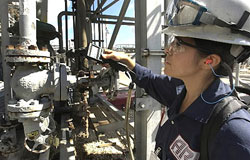
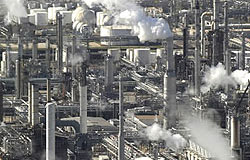
Environmental Inc., checks to see whether a valve at Shell Chemical in
Deer Park is leaking. The valve is one of 250,000 parts that federal and
state law requires Shell to check for leaks, which are large sources of
air toxics from chemical plants and refineries.
On a breezy day, Shell's 600-acre chemical plant in Deer Park turns into
a giant wind chime. Hundreds of thousands of metal tags, each etched with
chemical names like benzene and ethylene, dangle from nearly every pump,
joint and valve, creating a metallic orchestra amid the miles-long maze
of pipes. "There are so many of these and they are so close together,
even the slightest breeze can cause them to move," said an environmental
specialist at the facility. "In some units, the tags are so dense
the noise is noticeable." Their sound belies a sober purpose. Each
tag marks a place where toxic air pollution can escape.
Across Texas, these so-called fugitive emissions account for a sizable
portion of the toxic air pollution released by industry each year, some
of which ends up in surrounding communities. The tangle of tanks, stacks,
pipes and cooling towers that make up a chemical plant have thousands
of places which can leak air toxics.
Companies must check each potential leak point at least four times a
year for most chemicals. Fugitives no doubt contributed to the elevated
levels of air toxics detected by the Houston Chronicle at residences along
the fence lines of some plants in Houston, Baytown, Freeport and Port
Neches last summer. For nearby communities, these seemingly modest sources
of pollution can be more dangerous than what comes out of an industrial
plant's sky-grazing stacks, since many of the leaky parts are close to
the ground, where wind speeds are lower and the chemicals don't easily
disperse.
Toxics "hang around when they are released at a lower level,"
said the director of the Institute for Multi-dimensional Air Quality Studies
at the University of Houston, which is modeling air emissions in the Houston
area.His research, thus far, suggests that leaks of toxic pollution are
underestimated. "Fugitives are not being counted properly,"
he said.
State and federal investigations over the past five years also suggest
that the proportion of air toxics attributed to leaks is likely greater
than reported, since numerous facilities have been caught low-balling
the number of "leakers" at their facilities and the amount of
pollution they emit. Besides the accounting problems, current regulations
also allow some leaks to continue for years.
'There have to be leaks'
One thing is certain: no chemical plant or refinery in Texas is airtight.
"There have to be leaks. If you came back with no leaks, they would
say, 'Hey, what's going on?' " said a worker who has worked for four
years as a site supervisor for ARI Environmental Inc., the contractor
hired to monitor most of the 250,000 tagged components at Shell Chemical
whose design or age gives them pollution-releasing potential.
Baeza's 14 technicians spend 40 hours a week - divided into four 10-hour
days - walking along the chemical plant's pipes and measuring for leaks.
Some are so tiny that a permanent marker would give off more emissions.
Others leak so much that the concentration of the chemicals in the surrounding
vapor is four times over state and federal limits. Taken together, their
impact can be dramatic. In 2002, according to the federal Toxics Release
Inventory, leaks made up 33.3 percent of the more than 52 million pounds
of air toxics companies reported they released in Texas. The remainder
came from more obvious sources, including stacks and vents.
In Harris County, which in 2002 reported 11.4 million pounds of toxic
air pollution - the most in the state - industry estimated that fugitive
emissions accounted for 42 percent of the total. Not all fugitive emissions
are of one of the 188 air toxics, known to cause cancer and other health
problems. However, leaks account for more than 15 million pounds of other
types of air pollution in Texas, according to 2002 data. "These are
huge facilities with very complicated plumbing, basically," said
a spokesman for the U.S. Environmental Protection Agency, which wrote
many of the rules governing how leaks are detected and how fast they must
be repaired.
Of the 25 to 30 environmental regulations governing refineries and chemical
plants, six focus specifically on leaks. Many of those rules came into
being in 1990, when Congress updated the Clean Air Act and identified
the 188 hazardous air pollutants. Those rules were designed to reduce
fugitive pollution by 63 percent, if followed correctly. Yet despite the
regulations, the millions of dollars companies spend monitoring each year
and recent advances in leakdetection technology - including an infrared
camera that can actually photograph emissions coming off a pipe - a series
of investigations suggests that many leaks are being overlooked.
In June 2003, independent investigators working for the Houston Advanced
Research Center checked six chemical plants in the Houston area. All had
components that were not tagged or being checked for leaks. If they had
been, the amount of pollution reported to the state would have been slightly
higher.
In June 2002, the Texas Commission on Environmental Quality began unannounced
inspections of 53 cooling towers, which lower the temperature of chemicals
by transferring heat to water. At five of the nine industrial facilities
checked, the steam coming out of the cooling towers was laced with chemical
pollution, a sign of a leak. If these emissions were reported, the official
quantity of pollution reported by the plants would have gone up fivefold.
In 1999, the EPA's National Enforcement Investigation Center inspected
leak-detection and repair programs at 17 oil refineries nationwide, including
one in Texas City. It found four times as many leaks as the refineries
reported, resulting in 80 million pounds of unreported pollution.
The 1,062 facilities in Texas that reported releasing air toxics in 2002
emitted a total of 124 million pounds. The reasons cited for the missed
leaks included monitors not spending enough time checking the component
to get an accurate measurement and the difficulty of double-checking the
complex calculations used to determine how much pollution is coming from
a leaking part. ompanies contend they are abiding by calculations and
methods set by the EPA. "There are emissions problems with flares,
fugitives and cooling towers," said the executive director of the
Galveston-Houston Association for Smog Prevention, which released a report
in October 2003 on the TCEQ's cooling tower investigation. But, the executive
directory said, leaks alone can't explain the huge gap that researchers
have found between the concentration of chemicals in the air over Houston
and the emissionsestimates reported by the companies.
Scientists say the concentration suggests that actual emissions are five
times greater than what is being reported. Part of the reason is that
those numbers are estimates based on complex math and computer models,
not exact monitoring.
Focused on smog
Since the smog prevention group publicized the state data, Texas has
required refineries and chemical plants to keep better tabs on cooling
towers. But these efforts focus exclusively on butenes, propylene, ethylene
and 1,3-butadiene - the four chemicals in the Houston region that help
to form smog. Numerous other compounds that cause cancer and other health
problems are not subject to additional rules.
While the executive director of the Galveston-Houston Association for
Smog Prevention applauds the efforts, he would rather see pollution control
devices put on all leaking equipment or more frequent monitoring. The
contractors hired to detect leaks at most chemical plants and refineries
monitor most components only four times a year. At plants where less than
2 percent of the components are leaking, the state allows checkups to
be even more infrequent.
While companies like Shell have successfully built airtight plants in
Europe, the technology used there won't fit with the aging infrastructure
on the Texas Gulf Coast, where many plants were built in the 1940s and
'50s. Over time, aging equipment has been replaced, plants have expanded,
and some of those shut down have been turned back on. But not since the
late 1970s has a new refinery risen on vacant land in this country. The
last major new chemical plant was built in the early 1990s. Rising prices
for natural gas to fuel the petrochemical plants have forced many companies
to open new facilities overseas.
In the refinery business, strict environmental regulations and increasing
imports of crude oil have discouraged companies from building stateside.
"You couldn't retrofit this facility because there is no room,"
said the staff environmental specialist at Shell Chemical. "It's
almost impossible. You'd have to knock it down and start over again."
To reduce pollution at its plant, Shell goes beyond the requirements.
All pipes carrying benzene, a carcinogen, are routinely checked. And although
less than 2 percent of the plant's components were found to be leaking,
which could qualify it for an exemption, the company still completes quarterly
inspections. "We are trying to get those emissions down, and that's
how you do it - better monitoring," the staff environmental specialist
at Shell Chemical said.
At other facilities, too, environmental managers have made strides to
address some of the problems highlighted by the recent investigations.
The BP plant in Texas City, one of those inspected in the 1999 study,
now hires a second contractor to double-check its records. It also checks
how quickly leak investigators are working to make sure enough time is
being spent at each component. When the state inspected the plant in March,
not a single leak was detected in a check of 300 valves, said the environmental
superintendent. In places where there are leaks, however, detection doesn't
guarantee action. The most stringent rules, those regulating the hazardous
and ozone forming chemicals like 1,3- butadiene, require equipment leaks
to be repaired within a week.
Other chemicals are allowed to seep for years, because regulations allow
the company to wait to fix those leaks until its next major tuneup. These
happen, on average, every five years. At Shell, 200 leaks await repair.
The site supervisor for ARI Environmental Inc on her daily rounds, doesn't
even bother to stop at these. On a recent shift, she passed one with a
large orange tag indicating that it had been leaking since November 2003.
When it was last measured, the concentration of chemicals at the leak
was 2,225 parts per million. The allowable limit is 500 parts per million.
"In order to take it out of service, they would have to shut down
the entire line," the staff environmental specialist at Shell Chemical
explained, noting the possibility of bursts of chemical releases. "A
shutdown typically creates a lot of emissions." Farther down, the
site supervisor paused near valve No. 92181. It's part of a line carrying
propane and was last tested in July. She slowly waved a wandlike metal
probe over it. The valve passed.
View full story here
USA, CO, FRISCO, KEYSTONE, JANUARY 18 2005. FIVE INJURED IN KEYSTONE
CHEMICAL SPILL
An ambulance transported five people to emergency care Tuesday when two
noncompatible chemicals mixed after a spill at Keystone’s laundry
center, according to Snake River Fire Department Captain.
The negative reaction occurred when a delivery truck driver was switching
out cleaning solvents and two containers tipped over inside the laundry
facility, the Captain said.
One barrel was filled with chlorine bleach and the other with a phosphoric
acid, which are both liquid laundry agents, said public affairs coordinator
for Lake Dillon Fire-Rescue.
Lake Dillon Fire- Rescue, the Snake River Fire Department, an ambulance
and poison control responded to the building on Tennis Club Road shortly
after noon Tuesday. All seven employees in the building and the truck
driver were taken to a triage area for possible chemical inhalation. The
most serious cases were those complaining of chest tightness and itchiness
in their throats.
The seven employees and the truck driver went through a decontamination
process of washing exposed skin and clothes. The five patients who were
taken to the medical center changed out of their clothes and into chemical
suits so they wouldn’t spread contamination, the Captain said. Fewer
than 10 gallons spilled, nothing leaked outside the building and none
of the area buildings was affected, the Captain also said. Technicians
were also able to determine that the chemicals were no longer producing
gas, before they used various absorbents to sop up the spill, the Captain
said. The facility is in charge of all the laundry services for Keystone
Resort.
View full story here
USA, CHICAGO, JANUARY 20 2005. BARGE CARRYING PETROLEUM PRODUCT EXPLODES
IN CHICAGO
Authorities searched Wednesday for a man believed to be missing after
a barge carrying thousands of gallons of a gooey petroleum byproduct exploded,
caught fire and then sank in a ship canal.
The man was believed to have been working on the vessel when it burst
into flames in the Chicago Sanitary and Ship Canal on the city's southwest
side, said a spokesman for the Coast Guard in Chicago. The search was
suspended late Wednesday night and was scheduled to resume Thursday morning.
A boiler on the barge apparently exploded, igniting the clarified slurry
oil, which is a byproduct created when refining petroleum, said an Illinois
Environmental Protection Agency spokeswoman. She said initial estimates
indicate the barge was carrying about 13,000 barrels, or more than 500,000
gallons, of it. "This is a huge volume of petroleum byproduct,''
she said.
IEPA investigators went to the site of the explosion and crews tried
Wednesday night to determine how much of the substance might have spilled
into the 105- year-old canal, which serves as a link between the Great
Lakes and the Mississippi River.
Clarified slurry oil normally has the consistency of honey and becomes
thicker in cold water, which could lessen any potential environmental
damage, the Environmental Protection Agency spokeswoman said. "When
a substance is more liquid it spreads farther,'' she said. "When
it congeals or hardens it's easier to gather and remove. It doesn't mean
there won't be any problems, but this lends itself to ease in removal.''
She said Egan Marine Corp., operated the barge and the company would
be responsible for cleaning up any environmental damage. A woman who answered
the phone at the company located in the Chicago suburb of Lemontsaid they
would have no comment.
View full story here
USA, CHICAGO, JANUARY 21 2005. GOOFY RIDGE MAN INVOLVED IN BARGE EXPLOSION
- TUGBOAT CAPTAIN WAS PUSHING LOAD OF CLARIFIED SLURRY OIL
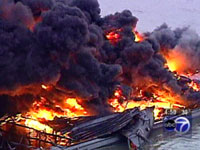
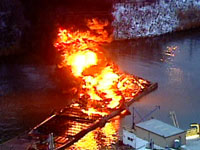
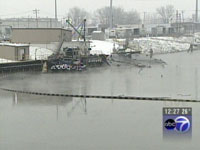
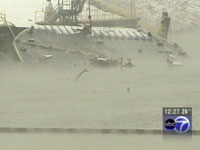
A central Illinois man was piloting the tugboat pushing a barge loaded
with thousands of barrels of petroleum byproduct when it exploded and
sank on Chicago's southwest side earlier this week.
The pilot of the boat, a resident of Goofy Ridge in western Mason County,
has been a tugboat captain for about eight years, his wife told the Journal
Star on Thursday. "He told me they were just a half an hour away
from docking (on Wednesday) when a couple of the men went out for a routine
check. ... My husband said all of a sudden there was a big explosion,
and he hit the floor," she said. "Debris was flying over. ...
Scraps of debris were hitting the wheelhouse."
The Captain's wife was working at the Pekin Wal-Mart when she received
the call about 5 p.m. Wednesday. "Witnesses told him that there was
such a loud explosion and flames they thought a plane had crashed because
it's close to Midway (Airport)," she said.
One of the tug's three crew members remained missing Thursday, authorities
confirmed. The Captain's wife said the crew was made up of two brothers,
one of whom is missing, and another man from the Lemont area where her
husband's family's business is based. Her husband and the other two men
were uninjured.
The missing crew member was believed to have been working on the vessel
when it burst into flames about 4:45 p.m. Wednesday in the Chicago Sanitary
and Ship Canal, said Chicago Coast Guard Petty Officer. The search for
the missing crew member resumed Thursday after being called off Wednesday
night.
A boiler on the barge apparently exploded, igniting the clarified slurry
oil, which is a byproduct created when refining petroleum, said Illinois
Environmental Protection Agency spokeswoman. She said initial estimates
indicate the barge was carrying about 13,000 barrels, or more than 500,000
gallons, of it. The Illinois Environmental Protection Agency spokeswoman
said Thursday that some of the fuel burned off during the fire, and it
was too soon to determine how much spilled into the canal. She said EPA
responders have found no signs of the sticky substance one mile downstream
from the barge site. "The fact that they were able to contain it
will certainly make cleanup easier because we'll be dealing with a welldefined
area," she said.
The 105-year-old canal serves as a link between the Great Lakes and the
Mississippi River. The barge was shipping the byproduct from an Exxon-Mobil
facility in Joliet, the Chicago Coast Guard Petty Officer said. Clarified
slurry oil normally has the consistency of honey and becomes thicker in
cold water, which could lessen any potential environmental damage, she
said. The Petter Officer also said Egan Marine Corp. operated the barge
and that the company would be responsible for cleaning up any environmental
damage.
A spokesman for Lemont-based Egan Marine said the barge made the same
trip twice before without any problems. "There are several questions
that have to be answered," the spokesman said. "Why that cargo
would explode and where was the source of the explosion." The Coast
Guard, which controls the port of Chicago and its waterways, ordered a
section of the canal closed indefinitely to maritime traffic to determine
whether the canal is safe.
The tugboat Captain's wife said her husband has never been a religious
man, but he told her when he heard the explosion, " 'God told me
to get down,' " she said. "It made a believer out of him."
CANADA, B.C, JANUARY 21 2005. CARBON MONOXIDE CAN HARM
THE UNSUSPECTING
Several warehouse workers in Newfoundland were hospitalized for symptoms
resulting from carbon monoxide poisoning in a recent close call, according
to the province’s Occupational Health and Safety department.
Propane powered forklift trucks were reportedly the source of their carbon
monoxide exposure. The warehouse relied on open doors as its only source
of ventilation. There was no mechanical ventilation.
In another incident on board a vessel in British Columbia, a crew member
felt dizzy during the night and got up to open the windows into the galley.
The next day, he found that the other crew member, who had been sleeping
in the bow area, had died. The ship’s engine, located under the
floor of the cabin, had a leak in its exhaust system, which allowed carbon
monoxide to seep through to where the crewmembers slept.
Both provinces have issued alerts to the public, stressing the importance
of safety measures such as gas detection and mechanical ventilation to
reduce the risk of carbon monoxide exposure. Carbon monoxide (CO) is generated
by gasoline and propane powered engines. The fact that it is odourless,
colourless and tasteless can make it difficult for people to realize they
have been exposed to the gas.
According to CHEMINFO, the effects of exposure can range from mild to
severe headaches (50 ppm to over 200 ppm); nausea, vomiting, dizziness,
fainting and drowsiness (above 400 ppm); increased heartbeat, irregular
heartbeat (above 1200 ppm); loss of consciousness and death (above 2000
ppm). At concentrations greater than 5000 ppm, death may occur in minutes.
These symptoms are usually seen sooner or at lower concentrations of carbon
monoxide if there is a heavy workload (increased breathing rate and increased
blood flow).
The Government of Newfoundland and Labrador recommends that in work areas
such as warehouses, employers should consider using alternatives to internal
combustion engines inside where possible. Where forklifts and other equipment
with internal combustion engines are run inside, the facilities should
have a mechanical ventilation system installed and maintained to control
the levels of exhaust gas to an acceptable level. In addition, where propane
powered forklifts are used inside a building, regular engine tuning and
emission testing should be a part of the equipment’s routine maintenance.
The carbon monoxide emissions should be within the maximum levels recommended
under manufacturers’ standards.
Employers should install carbon monoxide monitors throughout the work
area, including adjacent office areas. It is very important that these
CO monitors be maintained as recommended by the manufacturer. Workers
should be educated on the dangers of carbon monoxide and how to recognize
signs of poisoning.
On a sea vessel, a marine grade carbon monoxide detector should be installed.
The Workers’ Compensation Board of B.C. recommends configuring the
engine exhaust system and sealing engine compartments to ensure exhaust
gases cannot enter crew spaces. The system should be regularly inspected
and maintained. All crew spaces should have an adequate supply of fresh
air.
Read the full Alert - Government of Newfoundland and Labrador.
Read the full alert from the Workers’ Compensation Board of BC.
USA, MO, COLUMBIA, JANUARY 20 2005. MAN DIES OF INJURIES
FROM FUEL TANK EXPLOSION
A mid-Missouri truck driver has died from injuries he sustained when
a fuel storage tank exploded. The victim a resident of Ashland, died Wednesday
night at University Hospital, the Boone County coroner's office said.
The tank explosion occurred Jan. 7 at an MFA Oil Co. bulk storage facility
in Marshall as crews were unloading fuel from a tanker truck into one
of the aboveground storage tanks. The cause remains under investigation.
The driver was burned over 90 percent of his body.
SOUTH KOREA, JANUARY 22 2005. TOXIC FUMES CRIPPLE WORKERS
Eight Thai workers in South Korea who worked with toxic chemicals without
protective gear in closed, windowless rooms up to 14 hours a day, have
been paralysed.
South Korean police have arrested two employees at a factory blamed for
crippling the Thai immigrants. Police are questioning the plant manager
and a senior worker at Dongwha Digital over accusations that they broke
safety regulations while employing the women. Police are also hunting
for the company president, who disappeared after reports about the women's
plight were published.
Three of the eight Thai women returned to Seoul earlier this week to
receive medical treatment. They are suffering from severe nerve damage
that has paralysed them from the waist down. The women, aged between 19
and 37, were exposed to hexane - a toxic chemical used as a solvent to
polish products at the Dongwha factory, which builds components for liquid
crystal displays.
The colourless and odourless solvent can cause nerve damage when inhaled
repeatedly. 'They worked under harsh conditions in closed rooms without
windows for up to 14 hours a day, without wearing masks, gloves or goggles,'
said a representative of the Ansan Migrant Shelter.
USA, LA, BAKERSFIELD, JANUARY 20 2005. THREE WORKERS INJURED WHEN OIL
LINE IGNITES
A pipeline carrying crude oil at the Kern Oil & Refining Co. broke
Wednesday, igniting a fire that injured three employees who were hospitalized
for burns, authorities said.
The fire started shortly before 9 a.m., and three workers were treated
at the scene for moderate to serious burns and taken to the hospital,
said an engineer with the Kern County Fire Department.
One worker was released from the hospital after being treated for minor
burns to his face and the other two workers were en route to the Grossman
Burn Center at Sherman Oaks Hospital in Los Angeles, said a company spokesman.
He said refining operations were not interrupted and that workers extinguished
the fire soon after it started.
The cause of the pipeline rupture was under investigation.
CHINA, BEIJING, JANUARY 22 2005. TRUCK WITH 44 TONS
OF GASOLINE ON FIRE
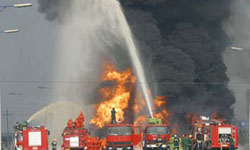
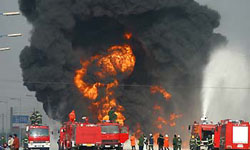
An oil truck carrying 44 tons of gasoline caught fire at 1100 am on Friday
in the Linzi district of Zibo of Eastern China'sShandong Province. A local
fire brigade arrived to the spot four minutes later and put on the fire
at 13:20 pm.
The roadwas full of bumps and holes because of the high temperature,
and covered with white foam and dirty water. The causeof the accident
is still under investigation.
View full story here
USA, NEW YORK, JANUARY 22 2005. BERSERK 'KILLER' HUBBY
Police say a man survived when he rammed his car into a gastanker trailer
after killing his wife. In Brooklyn, the woman's relatives broke down
in tears yesterday after learning of her death.
An enraged Brooklyn man stabbed his wife and fatally bludgeoned her with
a brick early yesterday, before ramming his car into a gasoline tanker
truck in an apparent suicide bid, police sources said. The man, 39, plowed
his Lexus sedan into the truck at about 2:30 a.m. while the 5,000-gallon
rig was parked at a Mobil gas station on the Belt Parkway.
The wreck left the Kensington man seriously injured and spilled thousands
of gallons of gasoline, police said. The apparent suicide bid came a short
time after the Brooklyn salesman got into a fatal domestic dispute with
his wife of 15 years, in which they fought apparently over a possible
breakup, police sources said.
The couple had a history of domestic trouble, including three incidents
reported to police since September. But friends and family said they could
not believe the pair's relationship could have led to murder. "My
sister didn't deserve this," said the victim's sister. "She
did not deserve to die." The couple's last night together began to
turn deadly about 1 a.m. yesterday, when the husband, who pals said hailed
from Jamaica, West Indies, allegedly attacked his wife, a hairdresser
who came from Barbados when she was 18.
Police sources said the wounds on the woman's body lead them to believe
she was stabbed in the side of her torso and hit in the head with the
brick. After the killing, the husband allegedly called the pair's live-in
nanny, who came home and found Joyce's body in a bathroom. The couple's
two daughters, ages 3 and 14, were also home, but unhurt.
The husband then went racing down the Belt Parkway. At 2:30 a.m. he hit
the tanker, which was delivering fuel to a station in the center median
near the Flatbush Avenue exit. The wreck left the husband in Lutheran
Hospital with a crushed hip and broken leg, police said.
Thousands of gallons of gasoline spilled. Some washed off into the wetlands
near Jamaica Bay, but most was captured in drains on station property.
The city Department of Environmental Protection ordered a cleanup of the
drain traps so the spillage does not seep into ground water.
The family of the deceased wife, meanwhile, began the difficult grieving
process. "She was an excellent woman, she came from a quality family,"
a friend said of the victim. "She came from a family that taught
good values. I am shocked."
AFRICA, WESTERN CAPE, JANUARY 25 2005. BLAZE DAMAGES PLASTIC FACTORY
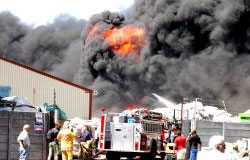
Firefighters, wearing special breathing apparatuses to protect themselves
from toxic fumes, battled for two hours on Monday to put out a fire that
extensively damaged a plastic recycling factory in Parow Industria. By
4pm, fire officials at the scene reported that the blaze had been extinguished.
According to the station officer at the fire control centre about 50
personnel, using eight pumps, two water tankers, two response vehicles,
two command buses, one hydraulic platform and one medical response vehicle,
battled to put out the fire. No injuries or deaths had been reported,
the station officer said.
Traffic in the immediate vicinity was disrupted for the duration of the
fire as firefighters battled flames on three sides of the building. The
station officer said the light wind that was blowing at the time did not
fuel the fire, although it blew the dense smoke across the Bellville area.
Staff at the factory, Plastic Cycle in Junction Street, had been evacuated,
as were people working in nearby buildings who had been affected by the
smoke, he said.
The senior fire officer at the scene confirmed that no injuries had been
reported, but said walls of an adjacent building had been damaged by the
smoke. The senior fire officer at the scene also said the fire had been
restricted to the rear part of the factory, where the plastic goods were
stored, and the rest of the building had not been damaged. He said the
fire department had received the report about the fire at about 1.30pm
and firefighters reached the scene minutes later. The blaze was under
control about two hours later, he said. He could not say what had caused
it.
View full story here
USA, NEW JERSEY, JANUARY 25TH 2005, THREE DEAD IN ACETYLENE PLANT EXPLOSION
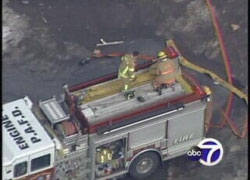
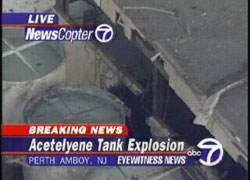
It has certainly been a tragic day in Perth Amboy because all of the
victims are from this community and it appears at this time that about
10:43 this morning there was an earth-shaking explosion when some acetelyne
gas was being tranferred from one container to another. Apparently there
was some sort of leak in that system.
Two people died on the scene and a third person died at the hospital.
This evening family members are trying to deal with the fate of their
loved ones. The tears were flowing outside the hospital as family members
of one of the victims found out the awful truth. One victim's family is
distraught. The victim was the youngest of thirteen children and many
of them came to the hospital or to the scene of the accident to find out
exactly what happened. At least two of the victim's family members worked
at the cetylene Service Company and one brothe said he quit the company
a couple of years because he thought it was too dangerous. The victim's
wife was pregnant with the couple's first child. As elderly parents came
to the emergency room and into the arms of family members they were overcome
with emotion.
Officials say they're still investigating but say that at this point
it appears a tragic accident. Perth Amboy's Mayor said "I would like
to first of all convey my condolences to all of the families who've been
affected by this accident. Our hearts and prayers are with them and we
can certainly sympathasize with their loss."
The aforementioned victim's birthday was supposed to be tomorrow but
now his family is planning for a funeral. The second victim died inside
the plant while the third victim died at the hospital.
A fourth living victim has been listed in critical condition at Robert
Woods Johnson Hospital. Eight other people were also taken to the hospital
but their injuries are considered minor.
The facility, located on the Arthur Kill River about 25 miles south of
New York City, provides liquid chemical and petroleum storage and handling,
as well as dry-bulk handling of salt and aggregates. |



